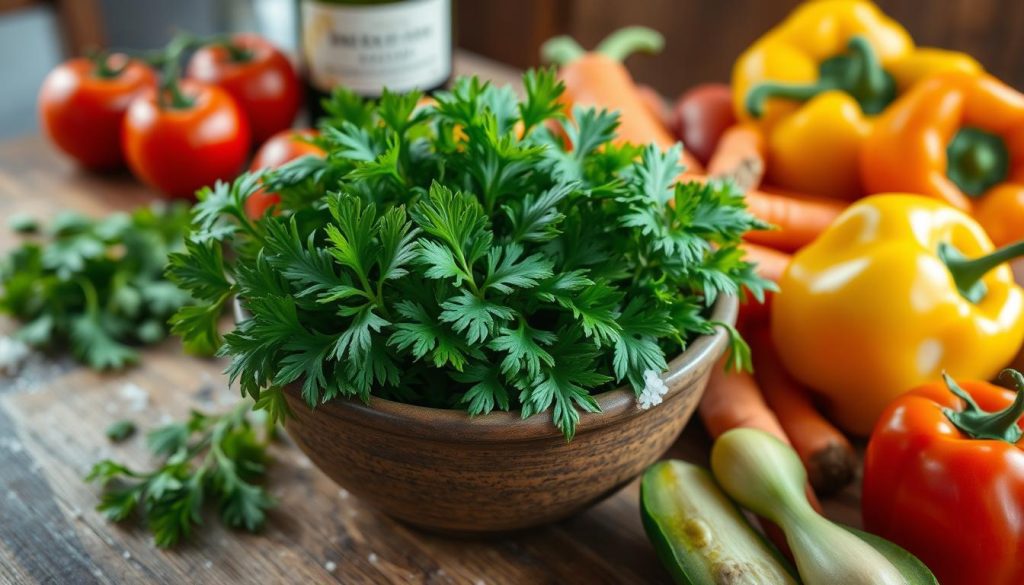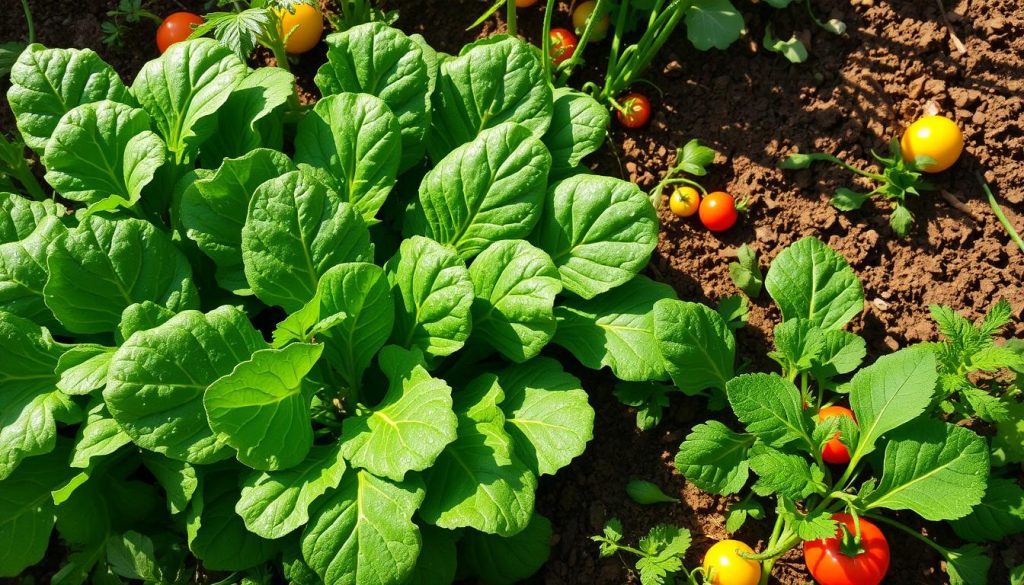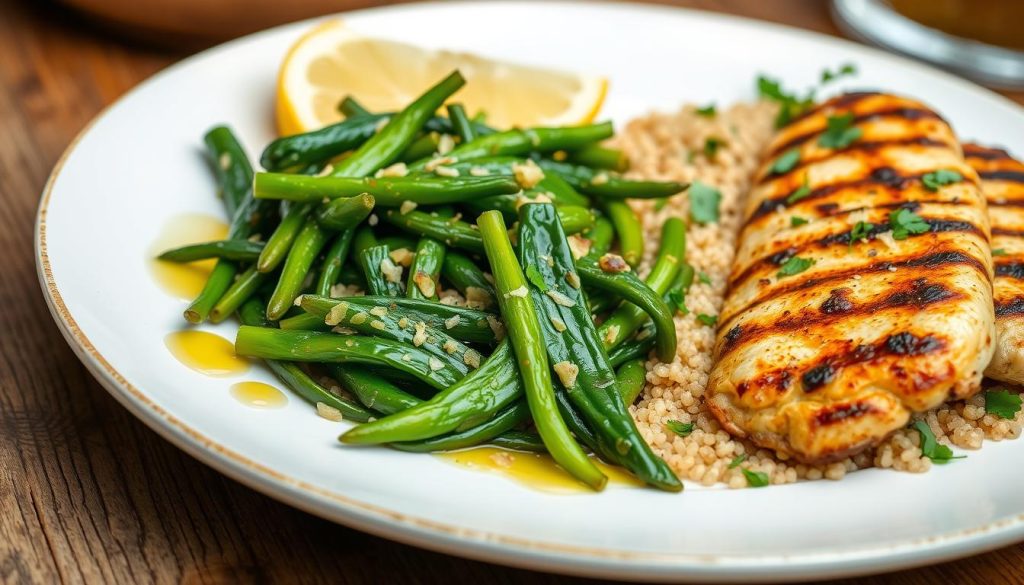Delicious Mustard Leaf Food: Fresh Garden Greens Guide
Delicious Mustard Leaf Food: Fresh Garden Greens Guide
Explore the world of mustard leaf food, a healthy and versatile ingredient. It comes from the Brassica family and is full of nutrients. This guide will cover everything about mustard leaf food, from its health benefits to how to grow and enjoy it.

Key Takeaways
- Mustard leaf food is a nutrient-rich leafy green with a distinct, peppery flavor.
- These versatile greens are packed with essential vitamins, minerals, and antioxidants.
- Mustard leaves can be easily grown at home, providing a fresh and sustainable source of nutrient-dense produce.
- Discover traditional Indian dishes and modern cooking techniques to showcase the unique flavors of mustard greens.
- Proper storage and preservation methods ensure the freshness and longevity of your mustard leaf food.
Understanding Mustard Leaf Food: A Nutritional Powerhouse
Mustard greens are a nutritional superstar. They are vibrant and packed with vitamins, minerals, and health-promoting compounds. Adding them to your diet is a great way to stay healthy.
Essential Vitamins and Minerals
Mustard greens are full of vitamins A, C, and K, and minerals like calcium, iron, and potassium. One cup of cooked greens gives you over 50% of the daily vitamins A and K. They are a nutrient-dense choice for your health.
Health Benefits for Your Body
Mustard greens have unique phytonutrients like glucosinolates and isothiocyanates. These compounds are antioxidants and anti-inflammatories. They may help lower the risk of chronic diseases, including cancer and heart disease.
Caloric Content and Dietary Fiber
Mustard greens are low in calories, with just 15 calories per cup. They are also a good source of dietary fiber, with nearly 3 grams per serving. Fiber helps your digestive system and keeps you full.
| Nutrient | Amount per Cooked Cup | % Daily Value |
|---|---|---|
| Calories | 15 | – |
| Carbohydrates | 3 g | 1% |
| Protein | 2 g | 4% |
| Fiber | 2.8 g | 11% |
| Vitamin A | 922 IU | 18% |
| Vitamin C | 27 mg | 45% |
| Vitamin K | 523 mcg | 654% |
| Calcium | 103 mg | 10% |
| Iron | 0.7 mg | 4% |
| Potassium | 184 mg | 5% |
Mustard greens are a true nutrient-rich vegetable. They offer essential vitamins, minerals, and health benefits. Adding these leafy greens to your diet boosts your mustard green nutrition and supports your health.
Growing Mustard Greens in Your Home Garden
Growing your own mustard leaf food, or mustang greens, at home is rewarding. These greens are full of nutrients and grow well in many gardens. They’re great for adding a healthy vegetable side dish to your meals or enjoying their fresh taste.
Choosing the Right Soil and Location
Mustard greens love well-drained, rich soil with a pH of 6.0 to 7.5. Pick a sunny spot in your garden for at least 6 hours of sunlight daily. If your soil is heavy, add compost to help with drainage and air.
Planting and Caring for Mustard Greens
- Sow mustard seed directly into the garden in early spring or fall, spacing the seeds about 1 inch apart and 1/2 inch deep.
- Keep the soil consistently moist, but not waterlogged, to ensure the seeds germinate quickly.
- Thin the seedlings to 6-8 inches apart once they have developed their first set of true leaves.
- Apply a balanced, water-soluble fertilizer every 2-3 weeks to provide the nutrients your mustard greens need to thrive.
- Regularly remove any weeds that may compete with your mustard plants for water and nutrients.
Harvesting and Enjoying Your Mustard Greens
Mustard greens are ready to harvest when the leaves are big enough, usually 4-6 weeks after planting. Cut the outer leaves, leaving the inner ones to grow. With good care, your plants will keep giving you greens all season.

Growing mustard greens in your garden is rewarding and tasty. With the right soil, sun, and care, you’ll have a lot of these tasty greens all season.
Traditional Indian Mustard Greens: Sarson Ka Saag Essentials
In India’s rich culinary history, indian mustard greens, or sarson ka saag, are highly valued. This dish is a favorite in northern India, where it’s enjoyed with great passion.
Authentic Preparation Methods
Making sarson ka saag is a detailed process. The mustard greens are washed, chopped, and cooked in a mix of spices like cumin and coriander. The slow cooking blends the flavors, making the dish warm and comforting.
Regional Variations and Serving Suggestions
Though the main ingredients stay the same, sarson ka saag has different versions across regions. Some add spinach or saag paneer, while others use special spices or herbs. It’s often served with makki di roti or tandoori roti, making a perfect pair.
Pairing with Traditional Indian Breads
The combination of sarson ka saag with Indian breads is a treat for the taste buds. The greens’ earthy taste goes well with the soft breads. Whether it’s makki di roti, tandoori roti, or naan, the mix is a delight.
Modern Cooking Techniques for Mustard Greens
Modern cooking techniques make mustard greens into tasty vegetable side dishes. You can sauté them or try new recipes. These mustard green recipes are full of nutrients.
Sautéing the greens with garlic, ginger, or shallots is popular. It softens their flavor and makes them tender. Braising them in broth or tomatoes makes them even more tender and flavorful.
You can also roast mustard greens for a crispy texture. Or blend them into pesto or add them to soups and stews. This adds a unique twist to familiar dishes.
- Sauté mustard greens with garlic and ginger for a flavorful side dish
- Braise the greens in broth or tomatoes for a heartier preparation
- Roast mustard greens for a delightfully crispy texture
- Blend the greens into pesto or incorporate them into soups and stews
With these techniques, mustard greens become a versatile and tasty part of any meal. Try different flavors and methods to find your favorite way to enjoy these leafy greens.

Preserving and Storing Fresh Mustard Greens
Mustard leaf food, also known as mustang greens, is packed with nutrients. It needs the right storage to stay fresh and healthy. Whether you grow them yourself or buy them, knowing how to store them is key.
Freezing Methods for Long-Term Storage
Freezing is a great way to keep mustard greens for a long time. Here’s how to freeze them:
- Wash the greens well and dry them with a towel.
- Blanch the leaves in boiling water for 2-3 minutes to keep their color and texture.
- Then, put the blanched greens in an ice bath to stop cooking.
- Drain the greens and pack them tightly in freezer bags or containers, removing air.
- Label the bags with the date and freeze for up to 12 months.
Best Practices for Fresh Storage
To keep fresh mustard greens crisp and tasty, follow these tips:
- Store them in the fridge in a plastic bag or airtight container.
- Don’t wash the greens until you’re ready to use them to prevent spoilage.
- Trim the stems before storing to help the leaves stay fresh longer.
- Use fresh mustard greens within 3-5 days for the best taste and nutrition.
Learning how to preserve and store mustard leaf food lets you enjoy their flavor and health benefits all year.
Conclusion
The mustard leaf is a nutritional powerhouse. It’s full of vitamins, minerals, and health benefits. Its vibrant green color and strong flavor make it a wonder of nature.
Whether you grow your own mustard greens or use them in cooking, they’re great for your diet. They add flavor to traditional Indian dishes like Sarson ka Saag. They also work well in modern recipes, showing off their unique taste.
As you look to eat healthier, try mustard leaf food. It’s full of possibilities for new recipes and ways to preserve it. Enjoy its fresh taste and bold flavor. Make your meals healthier and your body stronger with this amazing ingredient.
FAQ
What is mustard leaf food?
Mustard leaf food, also known as mustard greens or sarson, is a nutritious leafy vegetable. It’s eaten in many cuisines worldwide. These greens are full of vitamins, minerals, and antioxidants, making them great for a healthy diet.
What are the health benefits of mustard greens?
Mustard greens are packed with vitamins A, C, and K, and minerals like calcium, iron, and magnesium. Eating them can boost your immune system, support bone health, and improve overall well-being.
How can I grow mustard greens at home?
Growing mustard greens at home is easy. They need well-drained, nutrient-rich soil and cooler temperatures. Plant the seeds in the ground or containers. Water them often. Harvest the leaves when young for the best taste and texture.
What is Sarson Ka Saag, and how is it prepared?
Sarson Ka Saag is a traditional Indian dish made with mustard greens (sarson). It’s cooked with onions and spices until thick and flavorful. It’s served with hot Indian breads like roti or naan, loved in many Indian regions.
How can I incorporate mustard greens into my cooking?
Mustard greens are versatile and can be used in many dishes. Try sautéing them with garlic and chili peppers, or adding them to soups and stews. Their peppery taste goes well with bold flavors, making them perfect for curries, stir-fries, and pasta.
How do I store and preserve fresh mustard greens?
Store fresh mustard greens in the fridge in a plastic bag or airtight container. Don’t wash them until you’re ready to use them. For longer storage, freeze them after blanching. This keeps them fresh for longer.